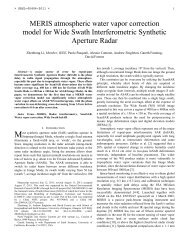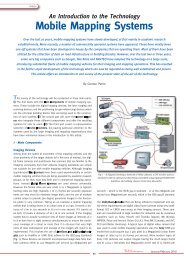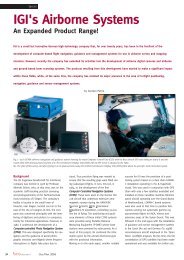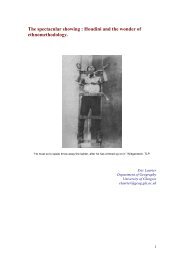From Imagery to Map: Digital Photogrammetric Technologies
From Imagery to Map: Digital Photogrammetric Technologies
From Imagery to Map: Digital Photogrammetric Technologies
You also want an ePaper? Increase the reach of your titles
YUMPU automatically turns print PDFs into web optimized ePapers that Google loves.
Conference<br />
A Report on the Greece 2009 Conference<br />
<strong>From</strong> <strong>Imagery</strong> <strong>to</strong> <strong>Map</strong>:<br />
<strong>Digital</strong> Pho<strong>to</strong>grammetric <strong>Technologies</strong><br />
With an installed base of 4,000 digital pho<strong>to</strong>grammetric workstations (DPWs)<br />
operating under 1,100 separate licences,, and with 400 individual organisations<br />
and companies using its PHOTOMOD software in over 50 countries, the Russian<br />
Racurs software company is a distinct success s<strong>to</strong>ry. So is its user conference,<br />
which is now in its ninth year and is looked forward <strong>to</strong> with much anticipation<br />
Following on from the 2007 and 2008 conferences<br />
that were held in Bulgaria and Croatia<br />
respectively, the organisers had once again<br />
selected an attractive seaside resort in southeastern<br />
Europe as the venue for the conference.<br />
In this case, it was the large Mare Nostrum Hotel<br />
[Fig. 1] located in the <strong>to</strong>wn of Vravrona on the<br />
Aegean coast of the Attica Peninsula, 35 km<br />
east of Athens in Greece. With its suite of conference<br />
halls and rooms [Fig. 2], it proved <strong>to</strong> be<br />
an excellent choice for the 2009 edition of this<br />
annual conference. Furthermore the organisers<br />
also followed the format that had proven <strong>to</strong> be<br />
very successful during the two previous conferences.<br />
Thus the first day was devoted largely<br />
<strong>to</strong> mapping from airborne imagery, while, on<br />
the second day, attention was concentrated on<br />
the acquisition and processing of spaceborne<br />
imagery. The third day was taken up with a<br />
by its now regular and devoted core of participants.<br />
By Gordon Petrie<br />
Fig. 1 – The Mare Nostrum Hotel at Vravrona, Attica, Greece – the venue for the 2009 Conference.<br />
(Source: K. Petrie)<br />
series of presentations and “master classes”<br />
focussing on the Racurs company’s own software<br />
products, while the fourth and final day<br />
was given over <strong>to</strong> a bus <strong>to</strong>ur of the Attica<br />
Peninsula for the participants. This culminated<br />
in a memorable visit <strong>to</strong> the ancient ruined<br />
Temple of Poseidon, perched high on its commanding<br />
site on the headland of Cape Sounion<br />
at the southern tip of the peninsula, as the Sun<br />
set over the Mediterranean Sea – which gave a<br />
fine end <strong>to</strong> a very good conference!<br />
Day 1 – Airborne Imaging &<br />
<strong>Map</strong>ping<br />
1 (a) – National & Commercial <strong>Map</strong>ping<br />
The conference opened with brief welcoming<br />
addresses given by [Fig. 3(a)], the<br />
managing direc<strong>to</strong>r of the Racurs company, and<br />
30<br />
of the Hellenic Military<br />
Geographical Service (HMGS). These introduc<strong>to</strong>ry<br />
speeches were followed by a more substantial<br />
account of the development and the<br />
current status of pho<strong>to</strong>grammetry in Greece<br />
given by , the agent for Racurs’s products<br />
in Greece. <strong>From</strong> this presentation, it<br />
appears that pho<strong>to</strong>grammetry is flourishing<br />
within the country, with the establishment of<br />
the Hellenic <strong>Map</strong>ping & Cadastral Organisation<br />
(HEMCO) providing a major source of work [See<br />
the Web site – www.okxe.gr/engprof.htm – for<br />
additional information]. Of further note was the<br />
information given about the HEPOS (Hellenic<br />
Positioning System) that provides real-time<br />
positioning services covering the whole of<br />
Greece through a network of 98 permanent GPS<br />
reference stations [See the Web site –<br />
www.hepos.gr/ – for more detailed information].<br />
The next speaker was of the<br />
Leibniz University of Hannover who gave an<br />
overview of pho<strong>to</strong>grammetry in the very specific<br />
context of cadastral systems. This was based<br />
on his own extensive experience of this activity,<br />
gained while acting as an adviser <strong>to</strong> a number<br />
of governments in different parts of the<br />
world. He estimated that currently only between<br />
30 and 50 countries have operational cadastral<br />
systems with a further 50 countries trying <strong>to</strong><br />
establish such systems. This means that over<br />
90 countries have no cadastral systems whatsoever.<br />
However there are numerous deficiencies<br />
even in those systems that are operational.<br />
The surveying and pho<strong>to</strong>grammetric technologies<br />
that are needed for the measurement and<br />
description of cadastral boundaries are widely<br />
available; the huge shortfall in their application<br />
is due almost entirely <strong>to</strong> institutional and political<br />
problems.<br />
The next presentation was given by<br />
of <strong>Map</strong> World <strong>Technologies</strong> in India, who provided<br />
an update on the progress of the massive<br />
New Delhi 3D Project that he had first introduced<br />
at the previous year’s conference held in<br />
Croatia. After which, there was a short presentation<br />
on the extensive use of the Racurs<br />
PHOTOMOD software in Bulgaria made on behalf<br />
of of the GIS-Sofia company.<br />
This was followed by a detailed account of the<br />
geo-information market in Russia that was<br />
given by of the country’s GIS<br />
December 2009
Association [See the Web site –<br />
www.gisa.ru/16183.html]. Among the many interesting<br />
items in this presentation was the news<br />
that, from 2010 onwards, no transactions in<br />
land can take place in Russia unless they are<br />
registered with the national cadastral system.<br />
The next presentation within this section was<br />
again given by . He gave an<br />
account of the numerous projects undertaken<br />
by students in surveying at the University of<br />
Nairobi, that make ingenious use of Google<br />
Earth <strong>to</strong> provide the image and map bases for<br />
their many varied and useful thematic mapping<br />
projects. Finally [Fig. 3(b)]<br />
gave an account of the extensive imaging and<br />
mapping activities of the Hellenic Military<br />
Geographical Service (HMGS) which is responsible<br />
for the national <strong>to</strong>pographic mapping of<br />
Greece, including the production and maintenance<br />
of 11,587 monochrome maps at 1:5,000<br />
scale and 387 multi-coloured maps at 1:50,000<br />
scale. The Service now has a new Internet portal<br />
for the supply of its maps, complete with<br />
an e-shop and electronic payment facilities [See<br />
the Web site – www.gys.gr/ – for more information].<br />
1 (b) – <strong>Digital</strong> Airborne Imaging &<br />
Equipment<br />
This section started with a series of presentations<br />
given by representatives of a number of<br />
[a]<br />
Latest News? Visit www.geoinformatics.com<br />
Fig. 2 – This Conference session<br />
is taking place in the<br />
Artemis conference hall<br />
within the Mare Nostrum<br />
Hotel. (Source: Racurs)<br />
system suppliers bringing the latest news about<br />
their products in the airborne imaging field <strong>to</strong><br />
the audience. of Leica Geosystems<br />
outlined the current status of the company’s<br />
ADS80 large-format pushbroom line scanner<br />
with its alternative SH81 and SH82 imaging<br />
heads; the RCD100 and RCD105 medium-format<br />
frame cameras; and the new PAV80 gyro-stabilized<br />
mount that can accommodate each of<br />
these digital imagers and indeed most other<br />
cameras that are available on the market. He<br />
also covered the ALS60 and ALS Corridor<br />
<strong>Map</strong>per that are having considerable commercial<br />
success in the field of airborne laser scanning.<br />
Similarly of Intergraph covered<br />
the corresponding Z/I Imaging products,<br />
including the DMC large-format digital frame<br />
camera. However his presentation focussed<br />
strongly on the company’s RMK-D medium-format<br />
multi-spectral camera [Fig. 4] that was<br />
announced last year and has now started <strong>to</strong> be<br />
delivered <strong>to</strong> cus<strong>to</strong>mers. Most interesting of all<br />
was the news that a new version of this camera<br />
(called the RMK-D/x) with an additional<br />
super-medium-format (12 k x 12 k) panchromatic<br />
channel will become available in the first<br />
quarter of 2010. A further development (called<br />
the RMK-D/lidar) featuring an Optech laser scanner<br />
instead of the panchromatic imaging channel<br />
will then follow later in 2010.<br />
Next of the Israeli Vision<strong>Map</strong> com-<br />
31<br />
Conference<br />
pany – who had described the company’s A3<br />
digital stepping frame camera at last year’s conference<br />
in Croatia – followed with the latest<br />
news about this rather novel product [Fig.5].<br />
This included the interesting news that seven<br />
of these cameras have already been sold. They<br />
comprise one sold locally <strong>to</strong> the Ofek mapping<br />
company within Israel and a further six <strong>to</strong> U.S.<br />
and European companies. The latter include two<br />
that have been sold <strong>to</strong> the Fugro EarthData<br />
company in the U.S.A. Finally, within this section,<br />
the present writer gave an<br />
account of current developments in airborne<br />
laser technologies. These include the introduction<br />
of much lighter and more compact systems;<br />
the use of higher PRF values (largely due<br />
<strong>to</strong> the introduction of the multiple pulse technique)<br />
and higher scan rates; and the more<br />
widespread availability of the full waveform digitizing<br />
of the pulse reflections from the ground<br />
as an optional feature. Furt hermore improvements<br />
in the supporting GNSS and IMU technologies<br />
have resulted in higher accuracies in<br />
the final elevation data that can be derived from<br />
laser scanning. Another noticeable trend has<br />
been the introduction of a number of lower cost<br />
and lower performance systems that are<br />
designed specifically for corridor mapping.<br />
1 (c) – Pho<strong>to</strong>grammetric Processing of<br />
<strong>Digital</strong> Aerial & Close-Range Images<br />
[Fig. 3(b)], the scientific direc<strong>to</strong>r<br />
of Racurs, began this section by tracing the<br />
development and the ever improving capabilities<br />
of the PHOTOMOD software and DPWs over<br />
the 15 years since it was first offered commercially<br />
in 1994. He was followed by<br />
of the Moscow State University of<br />
Geodesy & Car<strong>to</strong>graphy (MIIGAiK) who gave an<br />
account of his experiences with PHOTOMOD in the<br />
processing of close-range images for use in<br />
architectural pho<strong>to</strong>grammetry. In turn, he was<br />
followed by of the<br />
[b]<br />
Fig. 3 – (a) Dr. V. Adrov, the Managing Direc<strong>to</strong>r of<br />
Racurs, welcomes the participants <strong>to</strong> the<br />
Conference. (b) Captain A. Gkegkas (left) of the<br />
Hellenic Military Geographical Service (HMGS)<br />
giving his presentation, watched by his chairman,<br />
Dr. A. Sechin, the Scientific Direc<strong>to</strong>r of Racurs (on<br />
right). (Source: Racurs)<br />
December 2009
[a]<br />
Conference<br />
Fig. 4 – (a) The new Intergraph Z/I Imaging RMK-D multi-spectral medium-format airborne digital camera. (Source: Intergraph) (b) Showing the arrangement of the<br />
four lenses of the RMK-D camera with their attached filters that collect the image data in four separate spectral channels – RGB & NIR. The space in the housing that<br />
is at present blank will house either the lens of the additional panchromatic channel or the laser scanner in forthcoming models of the RMK-D camera.<br />
(Source: air-survey-base)<br />
National University of Athens (NTUA) who<br />
described the first experiences of himself and<br />
his colleagues using PHOTOMOD. The cited examples<br />
included the close-range pho<strong>to</strong>grammetric<br />
survey of a church in Cyprus and the mapping<br />
of the classical marathon course between<br />
Marathon and Athens from airborne imagery.<br />
of the Surgutneftegaz company then<br />
outlined her successful experience of processing<br />
the airborne digital images acquired by an<br />
IGI DigiCAM system using the PHOTOMOD software.<br />
After which, of the GIS-Sofia<br />
company described in detail the production of<br />
large-scale orthopho<strong>to</strong>plans of Sofia<br />
Municipality using PHOTOMOD, carried out on a<br />
block of 6,900 large-scale aerial pho<strong>to</strong>s that<br />
had been acquired using an Intergraph DMC<br />
digital camera. Finally returned <strong>to</strong><br />
describe a robust algorithm for the detection<br />
and measurement of tie points in large blocks<br />
of aerial pho<strong>to</strong>graphs using a newly developed<br />
image correlation technique.<br />
Day 2 – Spaceborne Imaging &<br />
<strong>Map</strong>ping<br />
2 (a) – Spaceborne Image Data Suppliers<br />
The day started with an overview and comparison<br />
of the capabilities of the newer very-highresolution<br />
WorldView-1 & -2 and GeoEye-1 satellites<br />
that was given by of the<br />
Sovzond company. After which, she then went<br />
on <strong>to</strong> make a further comparison of the relatively<br />
high-resolution spaceborne SAR imageries<br />
that are being generated by the newer radar<br />
satellites such as TerraSAR-X, COSMO-SkyMed<br />
and Radarsat-2. Finally she reviewed the capabilities<br />
of the various software packages – ENVI,<br />
INPHO, Bentley MicroStation – for which<br />
Sovzond are the agents. The next three speakers<br />
– A. Shumakov (GeoEye), B. Ber<strong>to</strong>lini (SPOT<br />
Image) and P. Ziemba (<strong>Digital</strong>Globe) – all spoke<br />
about their companies’ high-resolution spaceborne<br />
image data acquisition and products.<br />
had some interesting information <strong>to</strong><br />
impart about the characteristics of the forthcoming<br />
GeoEye-2 satellite that is currently under<br />
development for launch in 2012, including its<br />
use of a 1.1 m diameter primary mirror and the<br />
probability that the satellite will be licensed <strong>to</strong><br />
acquire its panchromatic image data with a GSD<br />
of 0.25 m. concentrated on the<br />
characteristics of the images (with a GSD of 0.5<br />
m) that will be generated by the two Pleiades<br />
satellites, the first of which is currently scheduled<br />
<strong>to</strong> be launched in Oc<strong>to</strong>ber 2010, with the<br />
second due <strong>to</strong> be launched 12 <strong>to</strong> 18 months<br />
later. Finally discussed the characteristics,<br />
capacity and coverage of the<br />
WorldView satellites, the second of which (WV-<br />
2) [Fig. 6] was actually launched on 8th Oc<strong>to</strong>ber<br />
– only two days after his very timely presentation!<br />
Indeed the first WV-2 images were collected<br />
on 20th Oc<strong>to</strong>ber – only 12 days after its<br />
32<br />
launch. He also announced the commissioning<br />
of two new ground receiving stations <strong>to</strong> receive<br />
spaceborne image data direct from<br />
<strong>Digital</strong>Globe’s satellites. These new stations are<br />
located in Europe (Germany) and the Middle<br />
East (Abu Dhabi) respectively.<br />
2 (b) – <strong>Technologies</strong>, Software &<br />
Processing of Spaceborne Image Data<br />
This section began with the report by<br />
of Ural Geoinform giving the results of<br />
tests of geometric accuracy and the interpretability<br />
of the medium-resolution imagery<br />
acquired by the RapidEye satellite constellation<br />
[Fig. 7] that was placed in orbit in August 2008<br />
and only came in<strong>to</strong> full operation in February<br />
2009. Using the RPC approach, the accuracy<br />
achieved at the check points within the test<br />
field was +/- 7 m (= one pixel). The interpretation<br />
of vegetation and agricultural land use on<br />
the RapidEye images could be carried out <strong>to</strong> a<br />
high standard of accuracy and completeness;<br />
however the location of pipelines and power<br />
lines was not always possible.<br />
of Sovzond gave further detailed information<br />
on the RapidEye satellites and imagery for<br />
which her company is the authorized distribu<strong>to</strong>r<br />
for Russia and the CIS countries. Already<br />
25% of Russia has been covered with RapidEye<br />
imagery [Fig. 8]. Then of Inforterra gave<br />
a fairly frank and honest assessment of using<br />
both the SAR interferometric technique and the<br />
December 2009<br />
[b]
[a] [b]<br />
Fig. 5 – (a) The latest version of the Vision<strong>Map</strong> A3 digital stepping frame camera in its new housing.<br />
(b) The stepping mechanism of the twin digital cameras that provide the cross-track coverage of the<br />
A3 camera. (Source: Vision<strong>Map</strong>)<br />
radargrammetric method employing a 3D stereo<br />
approach for the construction of DEMs. With<br />
the former method, the coherence of the overlapping<br />
imagery is all important; if there is low<br />
coherence, then the required DEM cannot be<br />
generated. Thus, for general world-wide applications,<br />
such as the construction of a global<br />
DEM, the radargrammetric approach is usually<br />
the more appropriate one <strong>to</strong> be utilized, even<br />
if the accuracy of the resulting elevation data<br />
is lower. Next of ScanEx outlined<br />
the many software packages that have<br />
been developed by his company for the processing<br />
of the spaceborne image data that is<br />
acquired by the numerous ground receiving stations<br />
that have been built by ScanEx. These<br />
include the specialist packages that have been<br />
developed <strong>to</strong> process Radarsat, Envisat and<br />
SPOT imagery. These can be supplied as boxed<br />
solutions with a fairly universal application as<br />
well as their specific use with ScanEx ground<br />
stations. The company has also developed a<br />
number of GISEye boxed solutions that are<br />
available <strong>to</strong> change image formats and <strong>to</strong> transform<br />
image data from one projection <strong>to</strong><br />
another.<br />
of the Panorama company<br />
then outlined the application of remote sensing<br />
image data for map revision and the generation<br />
of thematic maps using both boxed<br />
solutions and the cus<strong>to</strong>mized solutions that<br />
have been developed by the company. This was<br />
followed by a contribution by<br />
of the Grad Terri<strong>to</strong>rial Planning Institute in<br />
Omsk, who described in rather broad and general<br />
terms the use of remotely sensed image<br />
data for regional and urban planning purposes.<br />
The final presentation in this section was delivered<br />
by the present writer who<br />
gave an overview of the recent use of spaceborne<br />
imagery for environmental and disaster<br />
moni<strong>to</strong>ring, providing numerous examples<br />
world-wide, including many that had been<br />
acquired under the aegis of the International<br />
Charter on Space & Major Disasters.<br />
Latest News? Visit www.geoinformatics.com<br />
2 (c) – <strong>Map</strong>ping from Spaceborne Image<br />
Data<br />
This part of the programme began with a report<br />
from of the Goszem -<br />
cadastrsyomka (VISHAGI) organisation on her<br />
continuing series of tests of the high-resolution<br />
imagery from the Russian Resurs DK-1 satellite<br />
– which is available much more cheaply within<br />
Russia than the corresponding imagery from the<br />
GeoEye and <strong>Digital</strong>Globe companies. Using<br />
PHOTOMOD, planimetric accuracies of around +/-<br />
2 m have been achieved using both the RPC<br />
and strictly correct (rigorous) solutions over<br />
ground test fields. Her presentation was followed<br />
by a further report given by<br />
of the East Siberian affiliated branch of<br />
Goszemcadastrsyomka (VISHAGI). This gave<br />
details of the organisation’s widespread use of<br />
spaceborne imagery acquired by the various<br />
U.S. very high-resolution satellites for those of<br />
its mapping operations that are carried out at<br />
[a]<br />
33<br />
Conference<br />
1:10,000 scale. In practice, the interpretational<br />
properties of the imagery have proven <strong>to</strong> be<br />
very adequate for mapping at this scale. Next<br />
came a most interesting presentation by<br />
, the commercial direc<strong>to</strong>r of Racurs.<br />
He first outlined the company’s involvement<br />
with international tests of high-resolution<br />
imagery from newer satellites such as Car<strong>to</strong>sat-<br />
1 and GeoEye-1, for which the PHOTOMOD software<br />
produces geometric accuracy figures of<br />
approximately +/- one pixel in planimetry over<br />
well established test fields. On the production<br />
side, Racurs has undertaken various projects<br />
utilizing imagery from the SPOT, Kompsat-2 and<br />
Formosat-2 satellites for the <strong>to</strong>pographic mapping<br />
or orthoimage mapping of extensive areas<br />
at 1:25,000 scale in conjunction with DEMs that<br />
have been derived either from existing maps or<br />
from SRTM elevation data. The company has<br />
also supplied SPOT-5 imagery covering large<br />
areas in the Tyumen region of West Siberia <strong>to</strong><br />
various cus<strong>to</strong>mers in the oil and gas exploration<br />
sec<strong>to</strong>r. There was much else of interest in his<br />
presentation, which, in my opinion, needs <strong>to</strong><br />
appear as a written publication in a suitable<br />
journal <strong>to</strong> reach the much wider audience that<br />
would appreciate having this very valuable<br />
information.<br />
The last group of papers were all concerned<br />
with the classical use of spaceborne remote<br />
sensing image data within the field sciences.<br />
[b]<br />
Fig. 6 – (a) The <strong>Digital</strong>Globe<br />
WorldView-2 (WV-2) satellite – which<br />
has been constructed by Ball<br />
Aerospace. It is equipped with an 8channel<br />
multi-spectral pushbroom<br />
scanner supplied by ITT.<br />
(b) The launch of WorldView-2 <strong>to</strong>ok<br />
place at Vandenberg Air Force Base in<br />
California on 8th Oc<strong>to</strong>ber 2009 using a<br />
Boeing Delta-2 rocket. (Source:<br />
<strong>Digital</strong>Globe).<br />
December 2009
[a]<br />
of the Institute of Forestry based in<br />
Krasnoyarsk, Siberia discussed the use of this<br />
type of data in conjunction with a DEM <strong>to</strong> estimate<br />
forest conditions and dynamics in an area<br />
that is due <strong>to</strong> be flooded by a new hydro-electric<br />
plant. of NIIAS reported on the<br />
further use of spaceborne imagery for the moni<strong>to</strong>ring<br />
of the potentially dangerous impacts of<br />
underlying geology and soils on the railway<br />
infrastructure – a <strong>to</strong>pic that he had first introduced<br />
last year at the 2008 conference held in<br />
Croatia. Finally there was a group of three<br />
separate but linked papers presented by<br />
and of<br />
Gazprom VNIIGAZ, the giant Russian oil and gas<br />
company. With the search for new oil and gas<br />
fields moving ever further north in<strong>to</strong> the Arctic<br />
parts of Russia, SAR imagery has become ever<br />
more important in these areas where bad<br />
weather frequently occurs. Dr. Baranov had<br />
much <strong>to</strong> say regarding the use of interferometric<br />
SAR imagery, which is now being used <strong>to</strong> a<br />
considerable extent <strong>to</strong> moni<strong>to</strong>r the settlement<br />
of land due <strong>to</strong> the extraction of oil and gas –<br />
not only in the Arctic but also in the area of<br />
Astrakhan on the coast of the Caspian Sea.<br />
Other applications of SAR imagery by Gazprom<br />
include the moni<strong>to</strong>ring of areas of permafrost<br />
and active faults on the land and the moni<strong>to</strong>ring<br />
of sea ice around Novaya Zemlya and the<br />
detection of oil seeps in the Barents and Kara<br />
[a]<br />
Conference<br />
[b]<br />
Fig. 7 – (a) The constellation of five RapidEye<br />
mini-satellites that were built by SSTL<br />
(Surrey) in the U.K. Each is equipped with a<br />
JSS pushbroom imaging scanner built by<br />
Jena Optronik in Germany. (b) The RapidEye<br />
satellites are seen being placed on the Dnepr-<br />
1 launcher at Baikonur in Kazakhstan prior<br />
<strong>to</strong> their launch. (Source: SSTL)<br />
Seas along Russia’s northern Arctic coast as well<br />
as in the Caspian Sea.<br />
In summary, it is quite as<strong>to</strong>nishing <strong>to</strong> see and<br />
hear about the extensive use that is being made<br />
of spaceborne imagery in Russia as compared<br />
with the densely populated and highly developed<br />
countries of Western Europe where it has,<br />
by comparison, rather limited use. All of which<br />
appears <strong>to</strong> be a consequence of the sheer<br />
extent of Russia’s terri<strong>to</strong>ries, large areas of<br />
which are still sparsely populated and little<br />
developed.<br />
Day 3 – Racurs & PHOTOMOD<br />
The third day’s programme started with<br />
giving an overview of the PHOTOMOD<br />
software and of the various modules that currently<br />
form integral parts of its overall structure.<br />
However the PHOTOMOD Radar software package<br />
is really a separate stand-alone product<br />
designed for use with spaceborne SAR imagery<br />
rather than forming part of the main software.<br />
Similar remarks can be made (i) about the<br />
GeoMosaic product which can operate with digitized<br />
raster maps as well as airborne and<br />
spaceborne images; and (ii) the GeoCalcula<strong>to</strong>r<br />
package that carries out transformations<br />
between different projections and coordinate<br />
systems. But otherwise the modules within the<br />
main PHOTOMOD software system<br />
are highly integrated and very<br />
compatible with one another. Dr.<br />
Adrov also gave an account of<br />
some of the larger production<br />
mapping contracts that have<br />
[b]<br />
Fig. 8 – (a) A RapidEye image<br />
showing the centre of the<br />
city of St. Petersburg, Russia.<br />
(Source: RapidEye via<br />
Sovzond) (b) The corresponding<br />
plan of the city centre of<br />
St. Petersburg. (Source:<br />
Lonely Planet)<br />
34<br />
been undertaken by Racurs in its secondary role<br />
as a service provider. Besides those involving<br />
large numbers of aerial pho<strong>to</strong>s, this work has<br />
also included a project involving the mapping<br />
of 300,000 sq. km. from SPOT spaceborne<br />
imagery that was undertaken in 2007 and 2008.<br />
, the head of the technical support<br />
department for PHOTOMOD, then outlined some<br />
of the main features of PHOTOMOD 5.0, concentrating<br />
on the new analytical aerial triangulation<br />
system with its new and very reliable image<br />
correlation algorithm. Up <strong>to</strong> 20,000 images can<br />
now be accommodated in a single project.<br />
Another important change that has been incorporated<br />
in the new release is the dynamic rebuilding<br />
of the TIN network and con<strong>to</strong>urs while<br />
the editing of the elevation data is being undertaken.<br />
The new release now supports 16-bit<br />
raster data as well. , the head of software<br />
development at Racurs, gave still further<br />
information on the new release of PHOTOMOD<br />
from the computing point of view. It includes a<br />
revised data s<strong>to</strong>rage structure and a new data<br />
format based on ‘Open Standards’ (using TIFF<br />
and XML); a new integrated GUI; and extensive<br />
use of multiple distributed processors and dedicated<br />
hardware processing devices such as<br />
graphics processing units (GPUs) <strong>to</strong> speed up<br />
the overall operations of PHOTOMOD. Future<br />
developments will include a 64-bit version of<br />
PHOTOMOD. Finally, , who is the leader<br />
of the group developing the PHOTOMOD Radar<br />
software, spoke about the new possibilities that<br />
are being offered by its latest version. These<br />
include modules for coherent change detection<br />
and for object motion tracking (such as iceberg<br />
tracking). As one would expect, the software<br />
now supports the processing of the SAR<br />
imagery from the recently launched TerraSAR-X,<br />
COSMO-SkyMed and Radarsat-2 satellites. The<br />
InSAR processing of TerraSAR-X image data of<br />
the Ayers Rock area in Australia was used <strong>to</strong><br />
demonstrate the software in detail. All of these<br />
new features from both the PHOTOMOD and<br />
PHOTOMOD Radar software packages were then<br />
demonstrated further in the series of “master<br />
classes” that followed these presentations.<br />
Conclusion<br />
As usual, it was a busy, very well organised and<br />
very useful conference that sent the participants<br />
homewards in good spirits and well informed<br />
about the software and system developments<br />
that are being undertaken by the Racurs company<br />
– which is certainly not resting on its laurels<br />
and on its considerable and well earned<br />
reputation as a DPW supplier.<br />
Gordon Petrie is Emeritus Professor of Topographic<br />
Science in the Dept. of Geographical & Earth<br />
Sciences of the University of Glasgow, Scotland,<br />
U.K. E-mail - Gordon.Petrie@ges.gla.ac.uk<br />
December 2009
















